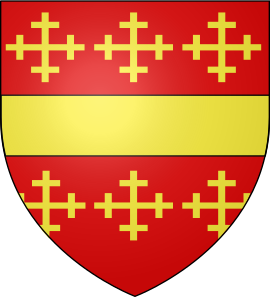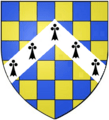Guy de Beauchamp, 10th Earl of Warwick facts for kids
Quick facts for kids
Guy de Beauchamp
|
|
|---|---|
| Earl of Warwick | |
| Born | c. 1272 |
| Died | 12 August 1315 |
| Buried | Bordesley Abbey, Worcestershire |
| Spouse |
|
| Issue See details |
|
| Father | William de Beauchamp, 9th Earl of Warwick |
| Mother | Maud FitzJohn |
Guy de Beauchamp, 10th Earl of Warwick (born around 1272 – died 12 August 1315) was a powerful English nobleman. He was a main opponent of King Edward II and the king's close friend, Piers Gaveston. Guy became the Earl of Warwick in 1298 after his father, William de Beauchamp, passed away.
Guy was a skilled leader who served King Edward I well. He fought bravely at the Battle of Falkirk. However, when Edward I's son, Edward II, became king in 1307, Guy quickly disagreed with the new king. He especially disliked Piers Gaveston, who had too much influence over King Edward II.
Warwick helped create the Ordinances of 1311. These were rules that limited the king's power and sent Gaveston away from England. When Gaveston returned, Warwick and another powerful earl, Thomas of Lancaster, had him executed. This act made some people feel sorry for the king.
Even so, Warwick and Lancaster managed to get a royal pardon for their actions. After a big defeat for England at the Battle of Bannockburn in 1314, King Edward II's power weakened again. The rebellious noblemen took control of the government. Guy de Beauchamp died the next year, but he is remembered for his role in these events. People at the time thought he was very wise and knowledgeable.
Contents
Who Was Guy de Beauchamp?
Guy de Beauchamp was the first son of William de Beauchamp, 9th Earl of Warwick. William became the Earl of Warwick in 1268. Guy was born around 1271 or 1272. His father named him after the famous hero, Guy of Warwick.
William de Beauchamp was a strong military leader. He played a key role in King Edward I's wars in Wales and Scotland. Guy followed in his father's footsteps, becoming a respected figure.
In 1309, Guy married Alice de Toeni. She was a wealthy heiress from Hertfordshire. By this time, Guy had already become the Earl of Warwick after his father's death in 1298.
Guy and Alice had two daughters and two sons. His eldest son, Thomas, later became the 11th Earl of Warwick. His younger son, John de Beauchamp, became a baron. John even carried the royal flag at the famous Battle of Crécy.
- Maud de Beauchamp (died 1366) married Geoffrey de Say.
- Elizabeth de Beauchamp (around 1316 – 1359) married Thomas Astley.
Serving King Edward I
Guy de Beauchamp became a knight in 1296. His public service began with the Battle of Falkirk in 1298. He fought well and was rewarded with Scottish lands. On September 5, 1298, Guy officially became the Earl of Warwick. He also became the High Sheriff of Worcestershire for life.
He continued to serve King Edward I in Scotland and other places. In 1299, he attended the king's wedding. In 1300, he took part in the Siege of Caerlaverock Castle. He also helped negotiate with the French king.
In 1304, he was at the Siege of Stirling. He served under Edward, who was then the Prince of Wales. In 1307, King Edward I gave Warwick the lordship of Barnard Castle.
On July 7, 1307, King Edward I died. Warwick was there when the king passed away. He helped carry the ceremonial swords at the coronation of King Edward II in 1308.
Disagreements with King Edward II
Before he died, King Edward I had sent Prince Edward's close friend, Piers Gaveston, away from England. Warwick was among those who were supposed to stop Gaveston from returning. However, the new king, Edward II, brought Gaveston back. He even made him the Earl of Cornwall.
Warwick was the only leading earl who did not agree with this decision. He immediately showed his dislike for King Edward II. Gaveston was not from a powerful noble family. He became very unpopular because he was arrogant and had too much influence over the king. He even gave rude nicknames to important noblemen. He called Warwick the "Black Dog of Arden."

Gaveston was forced to leave England again, but King Edward II brought him back less than a year later. At first, only Warwick opposed Gaveston's return. But over time, more noblemen grew unhappy with the king.
King Edward II also stopped his father's wars in Scotland. This allowed Scottish raiders to attack the border regions. Warwick owned a lot of land in the north, so this affected him greatly. Tensions grew so high that in 1310, the king had to ban Warwick and others from coming to parliament with weapons.
Despite the ban, they came armed. At the parliament in March 1310, the king was forced to agree to a group of noblemen. This group would create new rules to reform the royal government.
The leaders of these "Lords Ordainers" included Robert Winchelsey, the Archbishop of Canterbury, and the earls Warwick, Lincoln, and Lancaster. Warwick was seen as the most aggressive leader of this group. The rules they created, called the Ordinances of 1311, greatly limited the king's money and his power to choose his own ministers. They also ordered Gaveston to be sent away again.
The Death of Gaveston
Gaveston's third exile was very short. After only two months, he was back in England with King Edward II. The Archbishop of Canterbury responded by officially banning Gaveston from the church. Lancaster, who was now the leader of the noble opposition, went after Gaveston.
Gaveston hid in Scarborough Castle. On May 19, 1312, he agreed to surrender to Aymer de Valence, Earl of Pembroke. Pembroke promised to keep him safe.
Pembroke kept Gaveston in Deddington in Oxfordshire. On June 10, while Pembroke was away, Warwick forcibly took Gaveston to Warwick Castle. There, Warwick, Lancaster, and other noblemen held a quick trial. Gaveston was sentenced to death.
On June 19, Gaveston was taken to Blacklow Hill. This was on Lancaster's land. He was then executed. According to one old record, four shoemakers brought Gaveston's body back to Warwick. But Warwick refused to accept it and told them to take it back. Gaveston's body was eventually taken to Oxford by some friars. In 1315, King Edward II finally had it buried.
The harshness and questionable legality of the earls' actions made some people feel sympathy for the king. Pembroke was especially upset because his promise to keep Gaveston safe had been broken. From then on, Pembroke strongly supported King Edward.
The king himself swore to get revenge on his enemies. However, he could not act immediately. This was partly because the noblemen had many valuable royal jewels taken from Gaveston. A deal was made in October. The rebellious noblemen and their followers received a pardon.
Despite this, the king seemed stronger after these events. Warwick and Lancaster were mostly pushed aside. This changed in 1314. The king decided to launch a big military campaign against the Scots. Warwick and Lancaster refused to join. The campaign ended in a terrible English defeat at the Battle of Bannockburn on June 24. This led to another political change. Edward was forced to accept the Ordinances again and follow the leadership of the rebellious noblemen.
Death and Legacy
In mid-July, Warwick had to leave the government because he became ill. He died on August 12, 1315. After his death, political leadership mostly fell to Lancaster. Some people rumored that the king had poisoned Warwick.
Guy de Beauchamp was buried at Bordesley Abbey in Worcestershire. His family had supported this abbey for a long time. His wealth was second only to the Earl of Lancaster among all the English noblemen.
His lands were mainly in Warwickshire and Worcestershire. But they were also spread across nineteen other counties, as well as Scotland and Wales. His heir was his eldest son, Thomas, named after the Earl of Lancaster. Thomas was born around February 14, 1314. He did not become the Earl of Warwick until 1326, as Thomas de Beauchamp, 11th Earl of Warwick.
In the meantime, Warwick's possessions went to the king. The king even gave Warwick's hunting dogs to the Earl of Pembroke. Guy's younger son, John, also became a nobleman. He was known as John de Beauchamp, 1st Baron Beauchamp. Like his older brother, he fought bravely in the wars against France. He was also a founding member of the Order of the Garter.
Guy de Beauchamp is probably best known for opposing King Edward II and for his part in Gaveston's death. But to people at the time, he was seen as a very wise and knowledgeable man. He had a large library of books. He even gave 42 books to Bordesley Abbey during his lifetime. His library included stories about saints and tales of heroes like Alexander and King Arthur.
King Edward I trusted Warwick to supervise his son, Edward II. When the Earl of Lincoln died in 1311, he supposedly told his son-in-law, Thomas of Lancaster, to listen to Warwick's advice. Lincoln called Warwick "the wisest of the peers." Old records also praised Warwick's wisdom. One chronicle said that "Other earls did many things only after taking his opinion: in wisdom and council he had no peer."
Warwick's death came at a difficult time. Thomas of Lancaster was not as good at leading the country, which led to more years of conflict. However, King Edward II's reign had many deep problems. It is uncertain if even Warwick could have brought peace to the kingdom.
Images for kids




